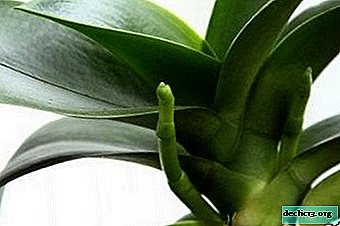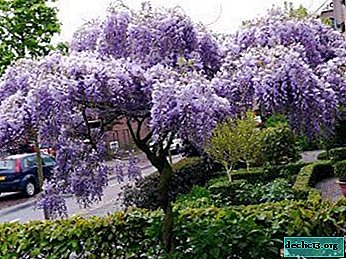What are aerial roots of orchids? Care Tips

The health of a houseplant depends on its root system. And most orchids have aerial roots. The question arises: what are they for?
They do no harm to the plant, but serve to store water in them and its further use.
In this article we will tell you how to care for the aerial roots of orchids and what problems you may encounter.
What it is?
ATTENTION: The aerial roots of an orchid are the thick roots of the plant’s common root system, which are located above the plant’s pot. They have a cylindrical or flat shape.In the structure of the roots there is a shell, or velamen, in structure resembling a sponge. It prevents mechanical damage to the root and prevents it from drying out during sunny periods, acting as a water reservoir. You can learn more about the structure of the entire orchid here, and in more detail about the structure of the leaves in this material.
 By the color of the roots, one can determine the stage of development of growth: a young plant with a bright green hue, while a pale and muted color is a sign of the old root system.
By the color of the roots, one can determine the stage of development of growth: a young plant with a bright green hue, while a pale and muted color is a sign of the old root system.
Observe the condition of the roots of the flower. If within a few months there are no new light green roots, it is necessary to reconsider the care of the plant and establish a different time and intensity of watering.
The root also has a growing tip, its size does not exceed 1 cm. It is translucent and covered with a thin white layer, which is very easily injured and leads to inhibition of plant growth.
How are they different from ordinary ones?
Orchids are epiphytes that do not grow on the earth and do not have a central root systemand use the roots in order to stay on other plants or on rocks, where there is more light and wind. Aerial roots grow at intervals along the main stem down (why do roots grow up?). Many grow above the lower leaves.
Why are they growing?
The root system is always in a phase of growth and renewal. Do not worry and immediately get rid of the roots crawling out of the pot. For some orchids, this is a natural state.
Why do you need it?
The roots play a supporting function of the orchid, supporting the ground part of the plant. They are necessary to obtain from the air the required amount of moisture and sunlight, actively participating in the process of photosynthesis.
What to do with them: step by step instructions
If there are a lot of them
- If the orchid has more than three airy roots, it is necessary to follow the watering regimen. With excessive moisture, the water balance is disturbed and the plant begins to grow in different directions.
- Reduce the number and frequency of watering, otherwise the roots will begin to rot and lead to the death of the plant.
- You can remove overgrown roots in the case of:
- if the roots began to rot from excessive watering;
- if the roots begin to dry out due to lack of moisture or too dry air.
If not
 The absence of aerial roots warns that orchids do not receive enough light or moisture.
The absence of aerial roots warns that orchids do not receive enough light or moisture.- An important role in the absence of roots is played by improperly selected filler. If a plant has not been transplanted for a long time, then it is soon necessary to change the soil and rearrange the plant to a more suitable place, enriching the soil with nutrients for fast and healthy development.
If there were only subordinate roots
Subsidiary roots weaken orchids. Therefore, it is necessary to carry out the following activities:
- Examine the damaged root system and carefully remove all dead and rotten processes, otherwise this process will go to a healthy fate and will be repeated again after a while.
- Disinfect cutting sites with brilliant green or activated carbon powder.
- Place the orchid in a ceramic or glass bowl filled with room temperature water. Change the water every day and regularly dry the plant.
- Maintain the necessary lighting and room temperature, it should not exceed 27 degrees.
Problems
Dry out
- Dry roots must be cut off immediately by treating the cut with iodine or activated carbon.
- If the number of dry roots exceeds the number of healthy ones, then the plant does not receive enough moisture and it is necessary to water the flower more often. Observe the watering regime and relative humidity in the room, especially on hot days.
Decay
 When the roots rot, a plant should be transplanted soon. Remove the plant from the old pot.
When the roots rot, a plant should be transplanted soon. Remove the plant from the old pot.- Wash the roots of the substrate in warm water.
- Remove any decayed areas by carefully cutting them at the base and sanitizing them afterwards.
- Put a pine bark on the bottom of the pot, having previously prepared it (boil it from an unnecessary amount of resin). To replace the bark, you can take a simple drainage. The layer should not exceed 1-2 cm.
- Carefully place the plant and cover it with the rest of the soil, being careful not to condense, to give the roots an air gap.
- After transplanting, observe the amount of moisture received, as well as the temperature regime of the room where the orchid is. Do not forget to alternate watering with periods of drying of the roots.
Plant care
- If possible, suspend the plant - This will be a favorable condition for the orchid. Then the roots will grow in length and it will be easier to observe them, in case of any deviation from the norm. In any other case, transplant into a transparent or translucent pot for orchids.
- Keep an eye on the incoming light. Do not keep the orchid in direct sunlight. If sunlight is not enough, then you can use a fluorescent lamp.
- Maintain optimal temperature: +18 to +30 degrees during the day and +16 at night.
- Do not forget to alternate watering and drying plants. On hot days, water daily, on cold days, every other day or two in the first half of the day.IMPORTANT: Do not spray and water the orchid in the evening or at night.
There are several ways to water an orchid:
- A warm shower is the best way. The flower is placed in a large container (bath) and watered from the shower with the most warm water, until the external roots become a greenish tint. After that, leave it alone for up to 30 minutes until the water has completely drained. You should also wipe the leaves with a napkin made of natural fabric.
- Immersion - a flower pot is immersed in water at room temperature for half a minute and then removed to allow water to drain. Used only for healthy orchids.
- Watering can - a plant is poured with water from a watering can, leading it along the edge of the pot until water begins to pour over the edges. Repeat again as soon as the water drains.
- Spraying - suitable for plants with bare roots, because they often dry out.
- Every month it is necessary to fertilize the plant with minerals. With a small amount of fertilizer, the plant begins to die. All components must be taken in equal amounts - about 13 grams. fertilizers for 10 liters of water. With excessive fertilizer, the orchid will be lethargic and soft.
- Replant the plant from time to time. Transplantation must be carried out after the orchid fades or in the spring. Before transplanting, carefully inspect and treat rotten roots.
A healthy looking flower always pleases the eye. This requires careful monitoring of the plant and proper care for it. Do not resort to various guardianship, but do not forget about the flower for a long time - all this puts the plant under unnecessary stress. Your flowers are in your hands!

 The absence of aerial roots warns that orchids do not receive enough light or moisture.
The absence of aerial roots warns that orchids do not receive enough light or moisture. When the roots rot, a plant should be transplanted soon. Remove the plant from the old pot.
When the roots rot, a plant should be transplanted soon. Remove the plant from the old pot.














